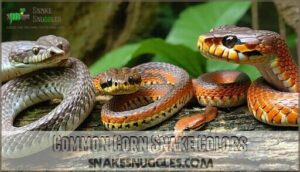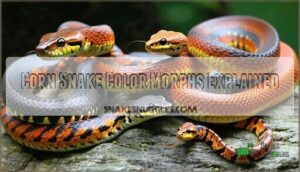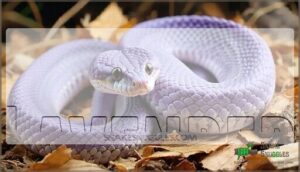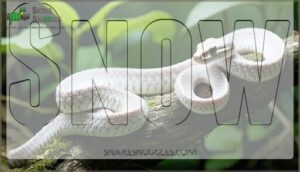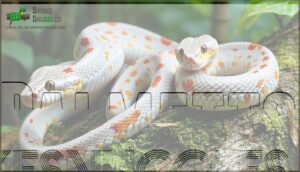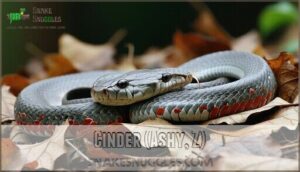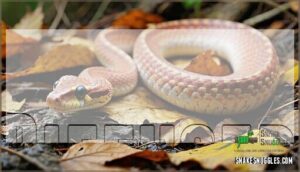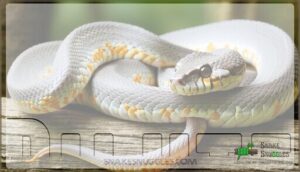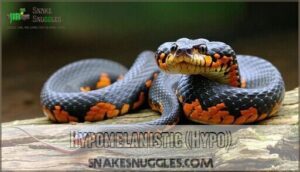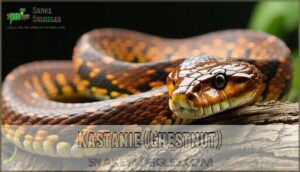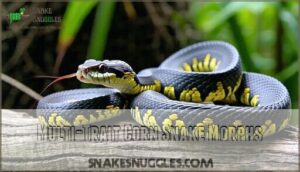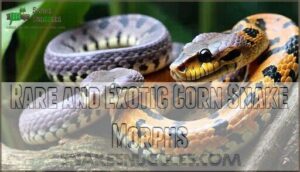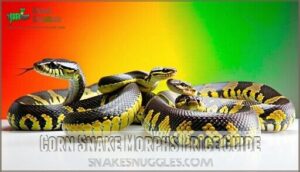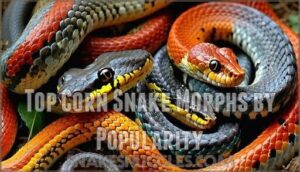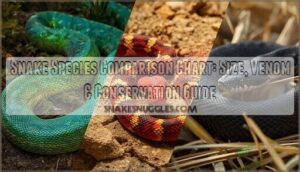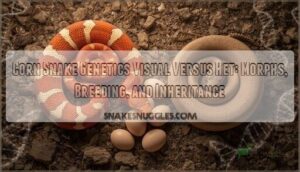This site is supported by our readers. We may earn a commission, at no cost to you, if you purchase through links.
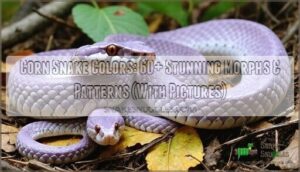
Corn snake colors result from genetic mutations, selective breeding, and recessive traits. You’ll find popular morphs like lavender, snow, and black, as well as unique ones like cinder and kastanie.
As you learn more about corn snake colors, you’ll uncover the intricacies of their patterns and traits, leading to a deeper appreciation of these beautiful creatures and their remarkable variations.
Table Of Contents
- Key Takeaways
- Common Corn Snake Colors
- Corn Snake Color Morphs Explained
- Popular Corn Snake Morphs
- Unique and Less Common Morphs
- Multi-Trait Corn Snake Morphs
- Corn Snake Color and Pattern Combinations
- Striking and Sought-After Corn Snake Morphs
- Rare and Exotic Corn Snake Morphs
- Corn Snake Morphs Price Guide
- Top Corn Snake Morphs by Popularity
- Frequently Asked Questions (FAQs)
- How dangerous are corn snakes?
- What colour eyes do corn snakes have?
- Are corn snakes the same thing as rat snakes?
- Is a corn snake a carnivore?
- What colors can corn snakes come in?
- Is there a purple corn snake?
- What is the rarest corn snake color?
- What is the prettiest corn snake?
- What is the lifespan of a corn snake?
- How do corn snakes change color as they age?
- Conclusion
Key Takeaways
- You’ll discover over 60 corn snake morphs with vibrant colors and stunning patterns, created through genetic mutations and selective breeding.
- Popular morphs like Palmetto, Lavender, Snow, and Okeetee showcase unique traits, offering something for every preference.
- Rare and exotic morphs like Scaleless and Cinder highlight the growing trend of designer genetics in corn snakes.
- Corn snakes are beginner-friendly pets, non-venomous, and long-lived, often displaying brighter colors as they age.
Common Corn Snake Colors
When you’re starting your corn snake journey, you’ll encounter five common color variations that form the foundation of this species’ genetic diversity.
These basic morphs include the wild-type Normal, the vibrant Okeetee with its bold black-bordered saddles, the silvery Miami with bright orange markings, the naturally reduced-pigment Keys variety, and the striking red-and-yellow Albino that lacks all black coloration.
The variety of these morphs, such as the Okeetee, showcases the species’ remarkable genetic diversity.
Normal (Carolina, Classic, Wild Type)
The normal corn snake represents the foundation of all corn snake colors.
This Carolina wildtype displays natural habitat patterns with earthy red-orange saddles against tan backgrounds. Wild-type genetics produce these classic markings found throughout their native range.
Regional variations exist, but conservation status remains stable due to adaptable wild behavior.
You’ll find normal morphs are perfect starter snakes—hardy, affordable, and beautiful. Their natural patterns showcase millions of years of evolution.
These wildtype specimens cost around $40 and demonstrate why corn snakes became beloved pets worldwide.
Okeetee Locality
You’ll recognize Okeetee corn snakes by their stunning red saddles outlined with bold black borders.
Named after the Okeetee Hunt Club in South Carolina, these snakes showcase vibrant orange-red coloration that’s hard to miss.
The Okeetee morph displays classic Okeetee characteristics – bright red blotches against an orange base.
Some breeders also produce reverse Okeetee variations with enhanced contrast.
Miami Locality
Miami phase corn snakes showcase Florida’s natural beauty with their distinctive silver-gray backgrounds and vibrant orange-red saddles.
These regional variations represent captive breeding success stories, maintaining their wild genetics through careful selection.
You’ll recognize Miami corn snake characteristics by:
- Miami Appearance: Steel-gray ground color with rust-red blotches
- Identifying Miami: Clean borders around saddle patterns
- Miami Genetics: Pure locality traits without morphing
Keys Locality (Rosy Ratsnake)
Found naturally in Florida’s Keys, the Rosy Ratsnake showcases stunning hypomelanism genetics that reduce black pigment levels.
You’ll notice this Keys locality displays beautiful brown base colors with orange or yellow patterns.
Captive breeding programs have helped maintain stable populations while conservation status remains secure.
Rosy Ratsnake care mirrors standard corn snake requirements, making these localities popular among collectors seeking unique corn snake colors.
| Feature | Details |
|---|---|
| Distribution | Florida Keys region |
| Genetics | Natural hypomelanism |
| Base Color | Rich brown tones |
| Pattern | Orange/yellow markings |
| Habitat | Coastal pine rocklands |
Albino (Amelanistic, Amel)
You’re exploring Albino corn snakes, also known as Amelanistic (Amel), which lack melanin, showcasing bright reds, whites, and yellows.
Albino genetics create Red-eyed morphs, with straightforward Albino care and various Albino variations, making amelanistic corn snake breeding intriguing, especially when considering corn snake morphs and genetics.
Corn Snake Color Morphs Explained
You’re about to explore the fascinating world of corn snake color morphs, where genetics and selective breeding come together to create unique and stunning patterns.
Discover the amazing world of corn snake color morphs and their unique patterns
As you learn about corn snake color morphs, you’ll discover how genetic mutations, recessive traits, and codominant genes contribute to the incredible diversity of colors and patterns in these amazing snakes.
Genetic Mutations
Lavender corn snakes get their color from a simple recessive gene. You’re seeing corn snake genetics in action! Corn snake color morphs involve genetic mutations, adding sparkle to nature’s palette.
Picture genes like artists, painting hues like amelanistic (albino) and anerythristic (no red pigment) varieties. You’re diving into snake genetics, where mutation origins create patterns.
With over 800 variations, breeders explore genetic strain combinations to create unique morphs.
- Mutation types
- Trait inheritance
- Breeding ethics
- Genetic diversity
Selective Breeding
You’re shaping corn snake colors through selective breeding, prioritizing genetic diversity and breeding ethics.
| Morph Development | Trait Selection | Genetic Diversity |
|---|---|---|
| Breeding Ethics | Future Morphs | Corn Snake Genetics |
| Snake Breeding | Corn Snake Morphs | Corn Snake Colors |
Recessive Traits
You’ll discover recessive traits in corn snakes, like anerythristic or amelanistic colors.
These hidden genes require both parents to pass them on, creating unique morphs.
- Recessive Inheritance
- Visual Expression
- Hidden Genes
Codominant Genes
You’re working with codominant genes, which create unique corn snake morphs.
Codominance examples, like Palmetto genetics and Tessera inheritance, show how genetic combinations produce stunning patterns.
Understanding codominance and incomplete dominance helps with breeding strategies, revealing how dominant and recessive traits interact to form diverse corn snake morphs.
Popular Corn Snake Morphs
You’re looking for popular corn snake morphs, and there are many stunning options to choose from.
You’ll find morphs like Lavender, Snow, Black, and Palmetto are highly sought after for their unique colors and patterns.
Lavender
You’re exploring Lavender corn snakes, a fan favorite.
Here are key points:
- Unique genetics
- Standard care
- Moderate price
- Stunning hues, making them a popular choice among corn snake morphs, with Lavender genetics and breeding creating beautiful corn snake colors.
They are known for their stunning hues, which contribute to their popularity.
Snow
You’ll love Snow corn snakes, with their dazzling white bodies and faint blotches, created by combining Amelanistic and Anerythristic genes, making them a unique and affordable morph, priced around $119.
These snakes have Snow genetics influencing their appearance and breeding, a popular choice among corn snake morphs and colors.
They need appropriately sized rodents to thrive, which is a key factor in their care and well-being as a unique pet.
Black
Have you ever seen a dark beauty? The black corn snake morph is stunning. Its deep charcoal hues are striking.
It’s often confused with Anerythristic morphs.
Did you know?
- Black pigment is key.
- It’s different from Cinder genetics.
- Charcoal variations exist.
- It’s not always Melanism effects.
- They’re easy to care for.
Despite their shadowy look, charcoal corn snakes are approachable.
Palmetto
You’re eyeing the Palmetto corn snake, a rare morph with a mostly white body and red, orange, and yellow speckles.
The characteristics of this snake can be summarized in the following table:
| Palmetto Genetics | Palmetto Care | Palmetto Rarity |
|---|---|---|
| Leucism variant | Similar to others | Highly sought |
| Unique genetics | Experienced breeders | Pricey |
| Challenging breeding | Rewarding keepers | Worth the hunt |
Unique and Less Common Morphs
You’re about to explore some of the most unique and less common corn snake morphs, including Cinder, Diffused, and Hypomelanistic.
These morphs offer distinct color and pattern variations that set them apart from more common types, and you’ll get to learn more about what makes them special.
Cinder (Ashy, Z)
Consider Cinder morphs for unique corn snake colors. You’ll notice a grayish look, sometimes called "Ashy" or "Z." Cinder Genetics produce muted colors, with reduced black pigment. Look for Red Undertones as they mature. This snake morph is an ashy gem.
Here’s what to know:
- Cinder Identification is easy with its ashy base.
- Body Composition is slender.
- It’s rarer than an anerythristic corn snake.
- Rarity Factors increase its value.
- It’s distinct from a Charcoal corn snake, and understanding these differences is key to recognizing the unique characteristics of the Cinder morph.
Diffused
You’ll appreciate the diffused corn snake’s smooth appearance, lacking belly checkers.
Key aspects include:
- Pattern fading
- Uniform appearance
- Breeding diffused morphs
- Corn snake color variations
- Pattern mutations, creating unique snake morphs with solid colors.
Dilute
You’ll notice Dilute corn snakes have a faded appearance due to their Dilute genetics, creating unique color variations with hypomelanistic or amelanistic corn snakes.
Affecting their overall health and care, with Dilute pairings resulting in subtle, beautiful dilute corn snake colors.
Hypomelanistic (Hypo)
You’re exploring Hypomelanistic corn snakes, which reduce black pigmentation.
- Hypo Genetics create unique variations
- Breeding Hypos requires careful planning
- Hypo Identification is vital for breeders
Hypo Health is generally robust, making them great pets, with stunning corn snake colors and morphs.
Kastanie (Chestnut)
You’ll love the Kastanie morph’s rich, chestnut hues.
Key features include:
- Warm color development
- Mandarin influence
- Persimmon pairings
The Kastanie morph showcases selective breeding’s beauty, with Kastanie genetics creating unique corn snake colors.
Multi-Trait Corn Snake Morphs
You’re about to explore multi-trait corn snake morphs, which combine multiple genetic traits to create unique colors and patterns.
As you learn about these morphs, you’ll discover how breeders mix and match traits like Aztec, Charcoal, and Tessera to produce stunning and one-of-a-kind corn snakes.
Aztec
After discussing less common morphs, let’s explore Aztec corn snake morphs. You’ll see their zigzag patterns and dynamic looks.
You’ll appreciate their versatility in breeding. They offer unique twists to the lineage. These pattern variations thrill visually.
They bring a playful spirit to any collection. Care is easy. They integrate seamlessly with other corn snake morphs.
They enhance every genetic trait.
| Feature | Details |
|---|---|
| Origin | Pattern Mutations |
| Color | Corn snake colors |
| Genetics | Aztec Genetics |
Charcoal
You’ll enjoy the Charcoal morph’s subtle gray and charcoal blotches.
- Charcoal genetics
- Pine Island origin
- Red undertones
distinguish it from Cinder, with no care differences, making Charcoal corn snakes a unique choice among corn snake colors and morphs.
Tessera
You’ll admire the Tessera morph’s unique, thin, dark-edged stripe.
Tessera genetics offer versatile breeding, creating striking corn snake colors.
Breeding Tessera results in various Tessera variations, making each tessera corn snake distinct, with prices varying based on Tessera appearance, a desirable addition to corn snake morphs and colors.
Caramel
You’re exploring Caramel corn snakes, known for warm hues.
- Neutral tones
- Genetic versatility
- Easy availability
Caramel Genetics create stunning combinations, making them a favorite among breeders of corn snake morphs and enthusiasts of corn snake colors, with Caramel Genetics being particularly notable for their genetic versatility.
Corn Snake Color and Pattern Combinations
You’re about to explore the amazing world of corn snake color and pattern combinations, where you’ll find solid colors, patterned morphs, and multi-trait combinations.
As you read on, you’ll discover how these combinations create unique and stunning visual effects, making each corn snake a one-of-a-kind pet with unique characteristics.
Solid Colors
You’ll discover solid corn snake colors, like amelanistic and anerythristic, result from Solid Color Genetics, offering unique appeal due to Solid Color Rarity, with various Solid Color Variations affecting Breeding Solid Colors and Solid Color Popularity.
Some albinos exhibit bright colors and patterns, lacking melanin, which is a key aspect of Solid Color Genetics.
Patterned Morphs
You’ll find patterned morphs in corn snakes, showcasing unique designs.
Some features include:
- Motley variations
- Stripe genetics
- Diffused effects
- Tessera expression
- Scaleless care, creating diverse corn snake morphs, like motley, striped, and tessera corn snakes.
This results in a wide range of diverse corn snake morphs.
Multi-Trait Combinations
You’re creating unique corn snake morphs by combining traits.
Combining traits creates unique corn snake morphs with stunning colors and patterns
Complex genetics come into play, making breeding challenging.
Visual identification of trait interactions is key.
As you explore genetic combinations and mutations, you’ll find popular corn snake morphs emerge from selective breeding, showcasing the diversity of corn snake genetics and the art of creating stunning visual effects through careful breeding practices.
Striking and Sought-After Corn Snake Morphs
You’re looking for the most striking and sought-after corn snake morphs, and there are several that stand out for their unique colors and patterns.
Some popular ones include Lava, Microscale, Terrazzo, and Scaleless, which are highly prized by collectors and enthusiasts due to their rare and stunning appearances.
Lava
You’ll love the Lava morph’s unique grayish-purple hue.
Lava Genetics play a pivotal role in Breeding Lavas, offering stunning Lava Variations.
This corn snake morph’s Lava Appearance stands out among color variations, making it a sought-after choice among enthusiasts of corn snake colors and snake morphs, particularly when exploring Diamond Crosses.
Microscale
You’re exploring Microscale corn snakes, known for their reduced-scale appearance.
Here are key points:
- Microscale genetics affect scale development
- Husbandry challenges require special care
- Microscale breeding is complex due to rarity, making them unique corn snake morphs.
Terrazzo
You’ve seen microscale’s unique look. Now, check out the Terrazzo. This snake morph has a patternless, grainy look. It’s like a living canvas.
Terrazzo appearance captivates many. With unique Terrazzo genetics and striking corn snake colors, Terrazzo stands out among corn snake morphs.
Whether it’s Terrazzo breeding or care, its history makes it prized. Terrazzo price can be high. Terrazzo identification is key.
| Feature | Detail |
|---|
————-:
canvas
Scaleless
You’ve admired the Terrazzo’s striking pattern. Now, imagine a scaleless corn snake! These unique corn snakes lack dorsal scales, showing off smooth skin.
Scaleless appearance makes them special, but scaleless husbandry is key. You’ll need to be extra gentle. Scaleless sensitivity requires careful handling.
Breeding these snake morphs is complex. Scaleless genetics are unique. Their scaleless rarity drives up the price.
- Scaleless care needs are specialized.
- Scaleless breeding is complex.
- Scaleless genetics are unique.
- Scaleless lifespan is comparable to other morphs.
Rare and Exotic Corn Snake Morphs
You’re looking for the most unique and exclusive corn snake morphs, and you’ve come to the right place.
As you explore rare and exotic corn snake morphs, you’ll discover limited edition morphs, high-end breeding programs, and unique genetic combinations that set these snakes apart from the rest.
Limited Edition Morphs
You’re seeking limited edition corn snake morphs, where rarity and unique genetic combinations drive demand.
These designer morphs, like Golden Nugget and Pearl Ghost, come with high price tags due to breeding challenges and genetic bottlenecks.
This situation raises ethical considerations about future availability and conservation concerns.
High-End Breeding Programs
You’re entering the sphere of high-end breeding programs, where corn snake morphs are crafted with unique genetic combinations.
These programs consider ethical considerations and investment potential to produce stunning, one-of-a-kind additions through selective breeding.
Unique Genetic Combinations
You explore unique genetic combinations in corn snake morphs, discovering dominant mutations and recessive genes.
Key aspects include:
- Hybrid Vigor
- Polygenic Traits
- Epigenetics
This sparks curiosity about corn snake morphs, genetics, and mutations, revealing new genetic combinations.
Corn Snake Morphs Price Guide
You’re looking to buy a corn snake, and pricing is a key factor in your decision.
You’ll find that corn snake morphs can range from $45 to $775, depending on their rarity and demand, so to make an informed decision, research and understand the price guide for different morphs.
Affordable Morphs
You can start with starter morphs like Normal, costing $40-$70.
Beginner genetics offer budget breeding options, with low-cost combos available in common localities, making corn snake morphs accessible, including color variations, with prices varying based on corn snake morph prices and demand.
Many owners find that they can acquire affordable pet snakes with relative ease, and this is due to the affordable nature of these pets, making them a popular choice.
Mid-Range Morphs
You’ll find mid-range corn snake morphs like:
- Caramel
- Lavender
- Aztec
- Tessera
These morphs offer great visual appeal and breeding potential, with relatively stable prices, making them popular choices among enthusiasts, considering morph popularity and genetic traits in corn snake morph prices.
Some morphs, like the Lavender, exhibit anerythristic genetic traits, which is an important aspect of genetic traits in corn snake morph prices.
High-End Morphs
You’ll discover that high-end corn snake morphs boast Morph Rarity and Unique Genetics.
These sought-after corn snake morphs attract collectors.
They feature rare patterns and colors.
Their prices reflect Breeding Challenges.
You can also purchase high-end snake products online.
Here’s a glimpse at some high-end snake morphs:
| Morph Name | Price Range |
|---|---|
| Cherry Amel Tessera | $1,100 |
| Caramel Bloodred Tessera | $1,100 |
| Terrazzo | Varies |
These corn snake colors have Investment Potential.
Following Future Trends in snake morphs can be exciting.
Investment-Grade Morphs
You’re looking for investment-grade morphs.
Consider:
- Lava morphs for stunning colors
- Palmettos with unique patterns
- Scaleless morphs for exotic looks
- Terrazzo morphs for price appreciation.
Many owners also buy specialized corn snake products for their pets.
Morph rarity and breeding potential impact corn snake morph pricing, making these investment-grade morphs valuable due to their genetic lineage and future demand.
Top Corn Snake Morphs by Popularity
You’re looking for the most popular corn snake morphs, and you’ve come to the right place.
As you explore the top corn snake morphs by popularity, you’ll discover a wide range of stunning colors and patterns that make these snakes unique and desirable pets.
Top 10 Corn Snake Morphs
You’ll adore the top 10 corn snake morphs, including Lavender, Palmetto, and Snow, each with unique characteristics.
Morph identification is key, considering genetics and care differences, which makes corn snake morph guide essential for enthusiasts to understand the various types.
Beginner morphs like Okeetee and Tessera showcase stunning patterns, making a morph guide crucial for those looking to learn more about these snakes.
Top 20 Corn Snake Morphs
You’re exploring the Top 20 corn snake morphs, featuring:
- Sunkissed
- Butter
- Caramel
- Creamsicle
These morphs showcase stunning color variations, making them highly sought after for morph identification and corn snake morph guide purposes.
Emerging Trends in Corn Snake Morphs
You’re witnessing emerging trends in corn snake morphs, with designer morphs and genetic testing aiding ethical breeding, leading to unique combinations and future genetics in snake breeding.
Driven by dominant mutations and hybrid vigor, this trend is expected to continue, with new and exciting developments in the field of snake breeding.
Frequently Asked Questions (FAQs)
How dangerous are corn snakes?
Actions speak louder than words" – you’ll find corn snakes are generally harmless, non-venomous, and not dangerous to humans.
This makes them a popular pet choice for many enthusiasts and beginners alike.
What colour eyes do corn snakes have?
You’ll notice corn snakes have eyes that are generally dark, with vertical pupils, and their eye color can vary.
But they often appear black or dark brown, depending on the morph.
Are corn snakes the same thing as rat snakes?
Did you know corn snakes are actually a type of rat snake?
They’re part of the same family, but not all rat snakes are corn snakes.
It’s like squares and rectangles—similar, but not identical, with complete concepts being key to understanding the difference.
Is a corn snake a carnivore?
Yes, corn snakes are carnivores. They eat prey like mice, lizards, and small birds.
In captivity, most owners feed them appropriately-sized frozen-thawed mice—an easy, nutritious meal that mimics their natural hunting behavior in the wild.
What colors can corn snakes come in?
Corn snakes are nature’s palette, showcasing colors like fiery reds, sunny oranges, earthy browns, silvery grays, and even snowy whites.
Selective breeding adds unique hues like lavender, caramel, and pink, creating endless vibrant combinations.
Is there a purple corn snake?
You can find lavender corn snakes, which have a soft, silvery-purple hue as adults.
Though not purely purple, they’re popular for their unique color.
Breeders often pair them with other morphs for vibrant offspring.
What is the rarest corn snake color?
Like a diamond in the rough, the Palmetto corn snake stands out as one of the rarest.
Its mostly white body, speckled with random colors, makes it highly sought after and pricey.
What is the prettiest corn snake?
The prettiest corn snake depends on your taste, but Palmetto morphs steal the show.
Their mostly white scales speckled with random colors create a stunning “paint-splatter” effect.
They’re a living masterpiece of nature.
What is the lifespan of a corn snake?
Your corn snake isn’t just a pretty face—it’s a long-haul companion, often living 15-20 years with proper care.
Treat it well, and you’ve got a scaly friend for nearly two decades!
How do corn snakes change color as they age?
As corn snakes grow, their colors often intensify or shift subtly.
Hatchlings might show duller patterns, but with age, their colors brighten or deepen, creating striking contrasts that evolve beautifully over time, enhancing their unique appeal, with colors that develop into a more vibrant display.
Conclusion
Imagine holding a living work of art in your hands—this is the beauty of exploring corn snake colors.
With over 60 morphs ranging from classic wild types to striking exotic patterns, these snakes showcase the incredible power of genetics and selective breeding.
Whether you’re drawn to the hypnotic lavender or the sleek black morph, there’s a perfect corn snake for every enthusiast.
By understanding their unique traits, you’ll deepen your appreciation for these truly remarkable creatures.

